Are you tired of losing money when playing flush draws in poker?
Bencb, a renowned poker pro, has some valuable advice for you. We'll dive into his strategic approach to playing flush draws, which can help you maximize your winnings and minimize your losses. From understanding the importance of stack-to-pot ratio to knowing when to raise, call, or fold, Bencb shares his insights on how to play flush draws like a pro.
This comes from Ben's recent YouTube release.
Hand #1
We flop a flush draw and we still have 80k behind, so we're relatively deep for a tournament.
He bets and, of course, I want to do a lot of raising.
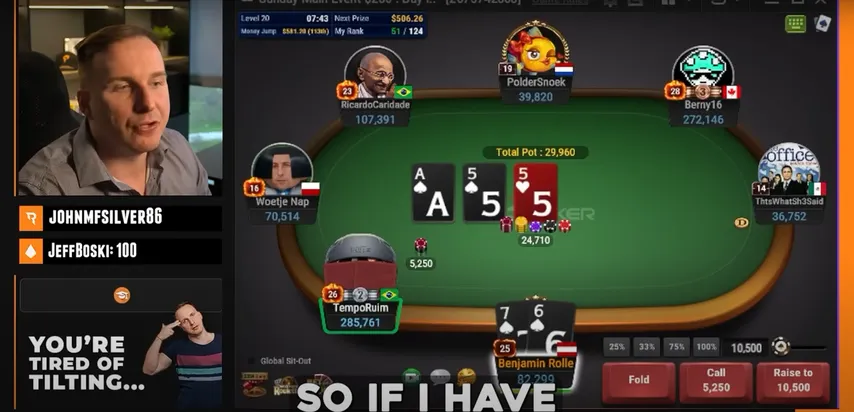
We defend from the big blind. We have hands like suited, suited, suited. We have a lot more hands than our opponent. Also, this hand we can improve to a lot of straight draws if I don't have any additional backdoor draws. So, let's say I have , I would just call because I also want to cooler his weaker draws. If I have something like , we have the possibility of making a flush and our opponent making a worse flush. So, if he has or or , if I have , , I would raise those hands to also make him fold something like , . We have the benefit of getting value from weaker draws and we start folding out better hands.
Here I would mix in something like , . Yes, we sometimes being cooler from a better flush draws, but we will also make some straight draws and we can also Bluff this hand to make him fold all of the better draws on the river. Now, the is good because he's still going to have something like pocket Jacks, pocket 10s, pocket 9s that now have to fold.
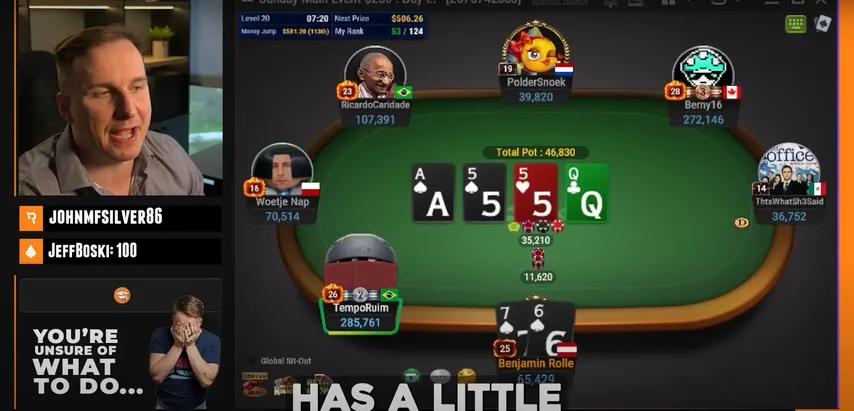
Even if we only bet a third, he's just almost drawing dead and everything that is bluffing has a little bit of equity.
On the river, we make the flush and you will not expect what this guy has on the river. I just jam for Value.
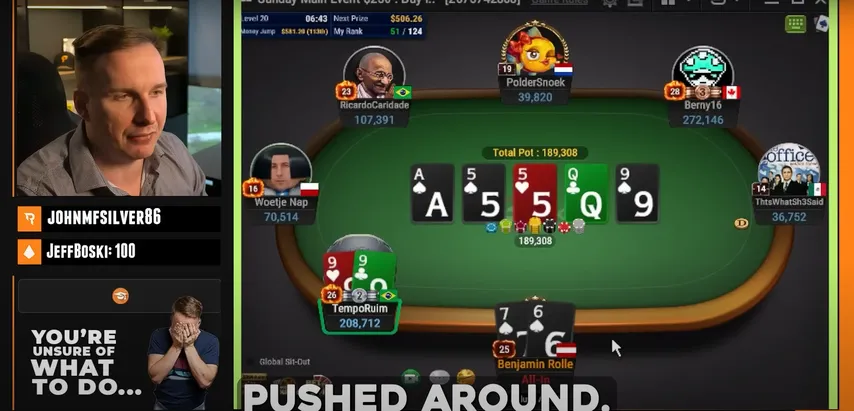
He can still have suited, suited is never going to be folding those. Yes, we're going to be being cooler from some like pocket Queens, but also Queens often check back. He can still have , . The is good, blocks a couple of his flush draws like , . is not possible. He's still going to have , and people are making crazy calls these days.
We jam and somehow this guy wakes up with pocket 9s. I had no clue what he was doing. He's the typical guy that never believes you, he puts you on the draw, and always calls, not understanding that in case we have value drawing that huge mistake. This is a big, big, big leak of many players that always focus on the potential Bluff your opponent can have and they don't like to be pushed around.
So here, concentrate also on the value part. If we have a , if we have an , he's drawing to two outs and that's never a good sign. You want to have at least an or a draw that you can continue with.
So, if we have a , you can redraw to a better flush when playing flush. It's a lot about the stack-to-pot ratio, meaning the equity realization.
– Editor's note: Plenty of free poker tournaments are happening right now and thousands of dollars are being awarded every day in their prize pools. Browse the events on our updated freeroll schedule and sift through costless events on some of the best poker sites.
Hand #2
Here in this spot, I 3-bet. We play a very shallow stack-to-pot ratio. We have 250k behind in a 140k pot.
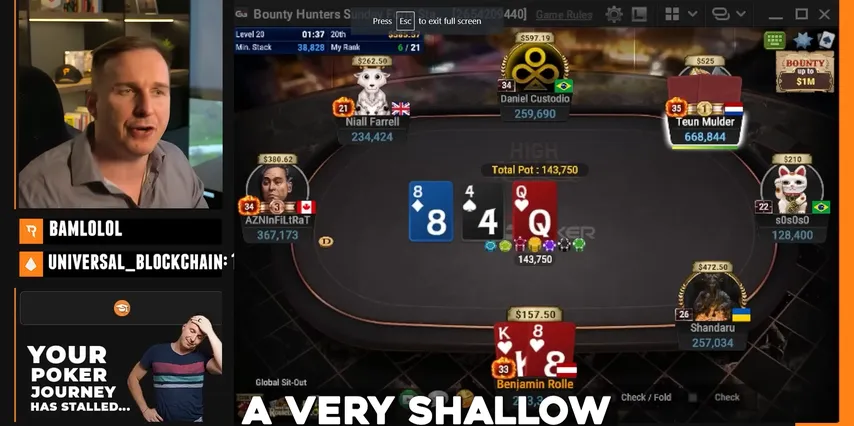
So, on the turn, I have a flush draw and, yes, we have shown value.
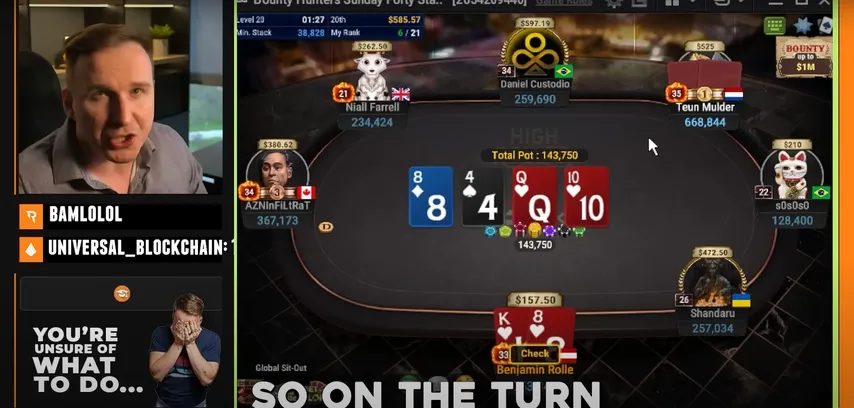
Of course, we're going to be checking back. It's a 3-bet pot, so his range is still relatively strong. He can still have , suited. But also, if you have , if you have , if you have and you decided to 3-bet those pre-flop and maybe you check back the flop and now you turn a flush draw, you should still be checking back. Because if you bet 40K, your opponent gets a great price on jamming a lot of hands like , , . Now you want to realize your equity and see a river card. That is so important.
If you have 500k or 600k behind, you want to start betting in case you hit your hand. You want to be playing a big pot. But the opposite is true if you play a shallower stack-to-pot ratio. Your first goal is to realize your equity and you're going to be bluffing a bit more polarized. So, in this spot, something like Ace 5 of clubs or maybe something like suited that you opted to 3-bet where you can make him fold or pocket 5s on the river. So, a lot of these spots turn from "let's try to build a pot in case we hit our draw" into "let's realize our Equity, hopefully, we hit something", and we choose other hands we Bluff with.
And here in this hand, we check back . He bets, I decided to raise.
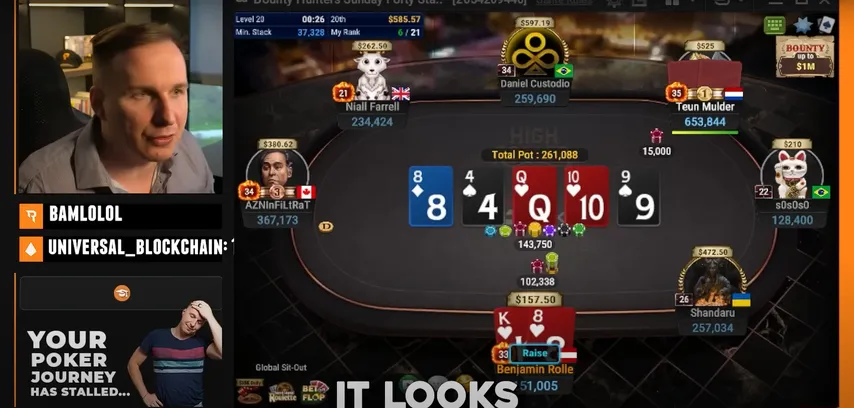
It looks pretty weak. We can have . I would play it also quite often like this, especially . I can still have pocket Jacks very likely. I can still also have . So, I have a bunch of hands I could raise here. I would even raise something like pocket 9s. Blocking , I think, is pretty sexy to raise, blocking a few sets.
Unfortunately, he had it, he jammed on me, and I had to fold.
Hand #3
I limped the facing a raise. I decided to limp, not to raise, because the button was a big calling station and I thought I'm not going to have as much fold equity as I'm supposed to have. So that's why I limped. Usually, I would raise this hand. Now, call is fine. We get a very good price with this hand. Also, it doesn't interact with his , , . If I have suited, I'm more likely to fold just because our outs are less often clean. But , suited, or even suited, (which I would just fold pre-flop, but if I get in the spot), I would call as well.
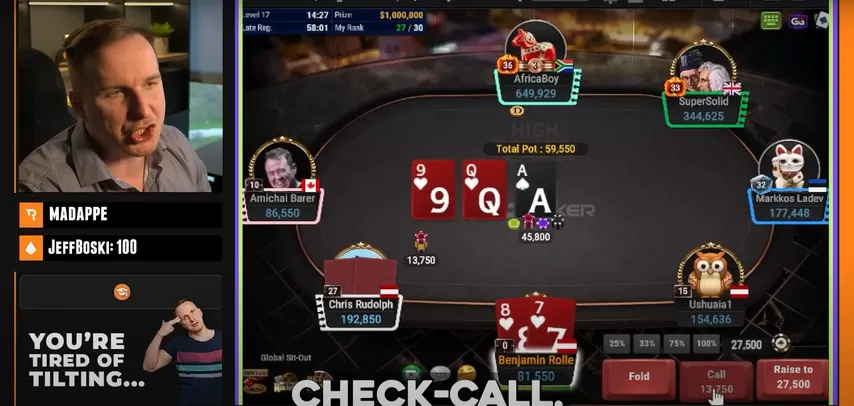
Flop, easy check-call.
I wouldn't hate check-jamming, but I also know that with this stack-to-pot ratio, he's going to be using a lot of small sizings later on, which exactly happened on the turn. So, against a bad player, we can just check-jam. But against a good player, I really like the check-call. As you can see on the turn, we get a very good price. It's less than a third pot, so we get the immediate odds.
Also, when it comes to playing flush draws and Christian Rudolph is an excellent player, you want to make sure you're not getting jammed off your equity. Meaning, if he has something like , , he would very likely check back the turn because we can jam and then he has to fold.
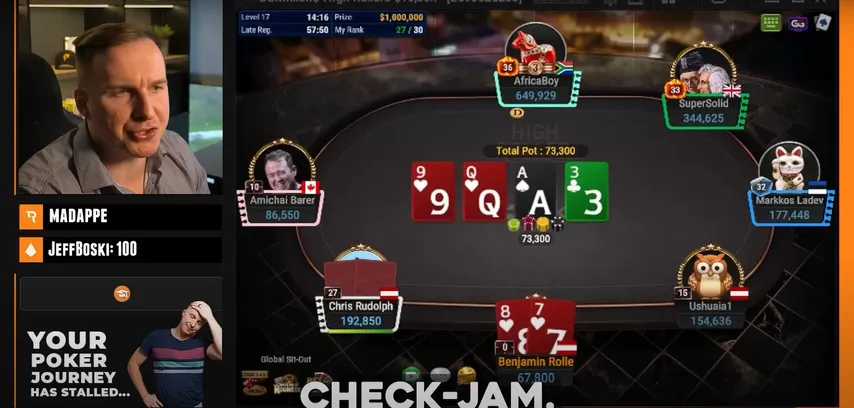
Also, something like , is so powerful that I would believe that he would mix in some checks from time to time. If you bet would bet over one-third, I would actually fold.
But can we jam now on the river? It gets pretty dicey because it also improves a lot of our range.
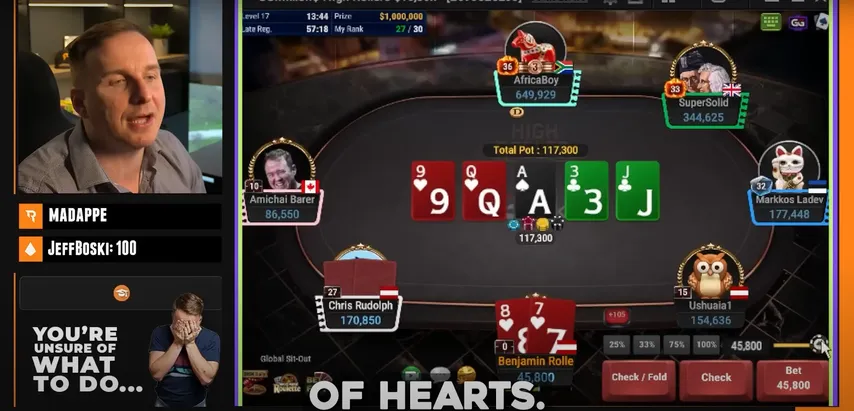
We're going to have , we can maybe have . We can improve to . We can have a few slow plays with suited. So once we get here to the river, we may have and . And if I have or if I have maybe I make the stake on the river, I want to jam because I believe if he has , , he's going to be checking it back a lot of the time. So that's why I decided to turn my hand into a bluff.
Also, he's going to have a lot of snap folds, which is very important when you bluff. , that gets there on the river. Maybe if he's a bit loose and he wants to play back against me, maybe . Even if he has or , it's going to be very, very dicey for him. He can definitely have something like that keeps betting the turn against all the draws that now fold on the river.
What a dumb hand, that's like probably one of the dumbest hands I've played in the past 10 or two years. Just the good old limp, see pre-flop, check-call, check-call, don't jam.






